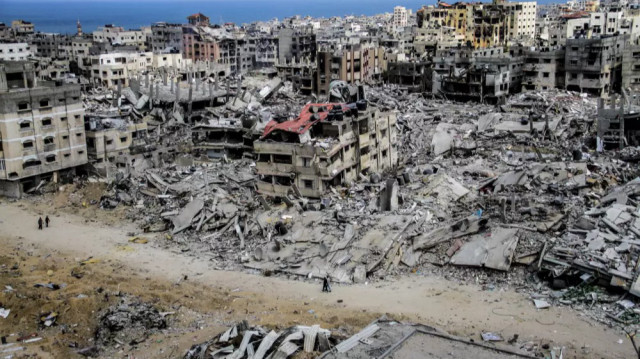
Yeni Şafak has exclusively obtained draft ceasefire documents detailing a ceasefire reached through international mediation between Israel and Hamas. It contains several phases, each lasting 42 days, and aims to achieve the temporary cessation of military operations, along with the prisoner and hostage swap, provision of aid to Gaza at a large scale and the facelift that the region requires. This is the first major development in the decade-old conflict which has spiraled down over the last few months.
Phase 1: Immediate Ceasefire and Humanitarian Aid
The first phase of the agreement begins with a temporary cessation of military operations between Israel and Hamas. The ceasefire calls for a complete Israeli withdrawal from populated areas of Gaza. Israeli forces will retreat eastward to the border regions, including areas such as Gaza Valley (Netzarim and Kuwait Square), which have been focal points of intense fighting. This move is aimed at reducing the immediate threat to civilians and facilitating the return of displaced persons.
In tandem with the military withdrawal, air operations for military and reconnaissance purposes will be suspended for 10 hours daily, and for 12 hours on days when hostages or prisoners are released. This measure is designed to provide an environment of relative peace and stability, allowing for humanitarian efforts to begin in earnest.
A critical aspect of the agreement is the return of displaced persons to their homes. By the seventh day of the agreement, Israel will completely withdraw from areas extending from Rashid Street to Salah al-Din Street, dismantling all military posts and infrastructure in the area. Humanitarian aid, including food, medicine, and fuel, will be allowed to enter Gaza without obstruction, marking the beginning of a much-needed relief operation. The return of displaced people will be carried out without carrying weapons, and the freedom of movement for residents throughout Gaza will be guaranteed.
Prisoner and Hostage Exchange: A Central Component
A major component of this first phase involves the exchange of prisoners and hostages. Hamas will release 33 Israeli detainees, including civilians, women, children (under 19, non-soldiers), the elderly (above 50), and injured or sick civilians. In return, Israel will release Palestinian prisoners, in accordance with a list provided by Hamas. The prisoner exchange is to be conducted as follows:
Hamas will release all living Israeli civilians (including women and children), and in return, Israel will free 30 Palestinian children and women for every Israeli civilian released, as per lists provided by Hamas based on seniority of detention.
Israeli female soldiers will also be released by Hamas, with Israel agreeing to free 50 Palestinian prisoners for each Israeli female soldier released.
Additionally, the release of Israeli hostages will be staged over several weeks:
On day one, Hamas will release three Israeli civilian hostages.
On day seven, an additional four Israeli civilian hostages will be freed.
Subsequently, Hamas will release three additional hostages every seven days, beginning with women (both civilians and soldiers).
By week six, all remaining civilian hostages will be released, and Israel will respond by releasing an agreed number of Palestinian prisoners, particularly those arrested after October 7, 2023, based on the lists provided by Hamas.
In case the agreed number of Israeli hostages to be released is not reached, the remaining figures will be filled with the bodies of those who have died. Furthermore, as part of the hostage exchange, no Palestinian prisoners released will be re-arrested for the same charges for which they were originally detained.
Humanitarian Relief and Infrastructure Rehabilitation
Starting from day one, the agreement includes the introduction of critical humanitarian aid into Gaza. An unprecedented 600 trucks of aid will enter Gaza daily, including 50 trucks of fuel. This aid will provide essential resources for hospitals, medical centers, and bakeries, and will ensure the re-opening of electricity stations. The goal is to support immediate humanitarian needs, such as food, water, and medical supplies, and to begin the process of clearing debris and rebuilding vital infrastructure across the Gaza Strip.
In addition to the aid, temporary shelters will be established for the displaced, including at least 60,000 temporary housing units (caravans) and 200,000 tents. These efforts aim to provide safe and secure housing for those who lost their homes during the conflict.
Phase 2: Sustainable Calm and Full Military Withdrawal
The second phase, which will begin by day 16, marks a shift toward a more permanent cessation of hostilities. The two sides will declare a return to sustainable calm, which will involve a complete Israeli military withdrawal from Gaza. All Israeli forces will leave the territory, and the exchange of prisoners and hostages will continue. This phase will also involve expanding the scope of humanitarian aid and starting the reconstruction of Gaza's key infrastructure, such as roads, water, and electricity systems.
By this stage, all remaining Israeli civilians and soldiers will be freed, and Israel will release a corresponding number of Palestinian prisoners from its detention facilities.
Phase 3: Reconstruction and Return to Normalcy
The third and final phase will begin after 42 days of the initial ceasefire. During this phase, efforts will focus on the exchange of remains of deceased combatants, which will be transferred between the two sides after identification. This stage will also see the reconstruction of Gaza on a massive scale, a process that will take 3 to 5 years. It will involve rebuilding homes, civilian buildings, infrastructure, and providing compensation for all affected individuals. The international community, particularly Egypt, Qatar, and the United Nations, will oversee the entire process to ensure that Gaza’s reconstruction is both effective and inclusive.
In addition to reconstruction efforts, crossings between Gaza and Israel will be reopened, allowing for the free movement of people and goods. This will facilitate trade, improve living conditions, and ultimately enable Gaza to reintegrate into the broader regional economy.
International Guarantees and Oversight
The agreement is backed by key international guarantors, including Qatar, Egypt, and the United States. These nations will play a crucial role in overseeing the implementation of the agreement and ensuring that both sides adhere to their commitments. Egypt’s diplomatic efforts have been central in brokering this deal, while Qatar and the United States have pledged support in the form of humanitarian aid, funding for reconstruction, and diplomatic pressure to ensure compliance.
As the world continues to witness the aftermath of the ongoing conflict, one undeniable truth emerges: Gaza’s people need our solidarity now more than ever. The historic ceasefire agreement between Israel and Hamas, though a temporary measure, provides a glimmer of hope for millions living in Gaza, who have endured unimaginable hardship. But this hope must not remain fleeting. It requires a collective commitment from the global community to support the people of Gaza—not just in the immediate aftermath, but for the long-term recovery, dignity, and justice they deserve.
Hello, the comments you share on our site are a valuable resource for other users. Please respect other users and different opinions. Do not use rude, offensive, derogatory, or discriminatory language.
The floor is all yours.








